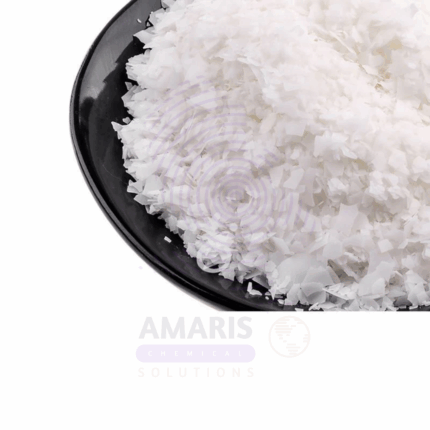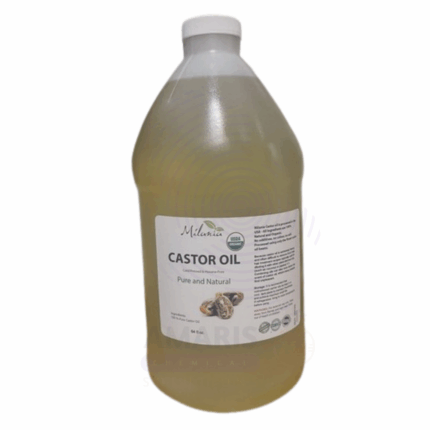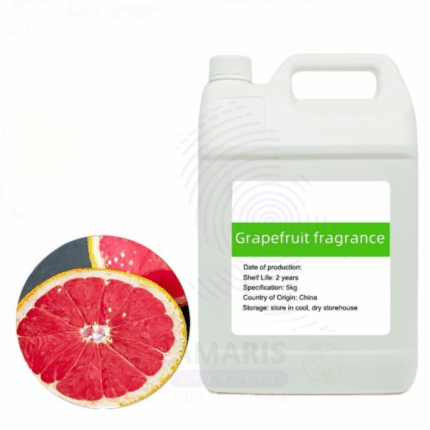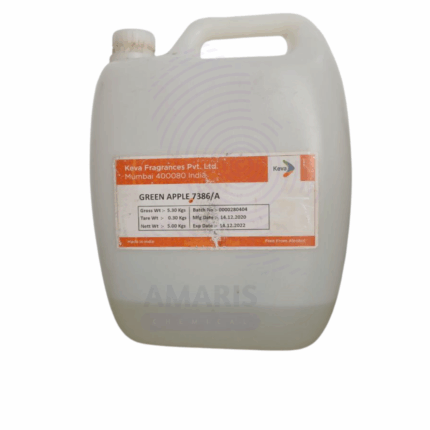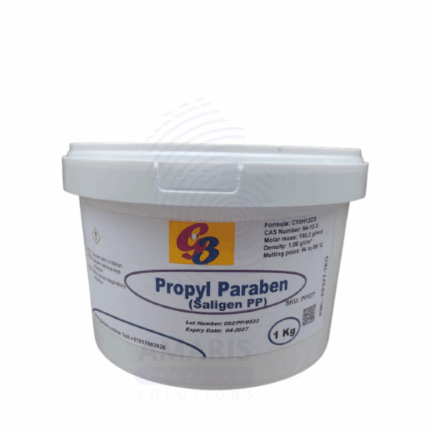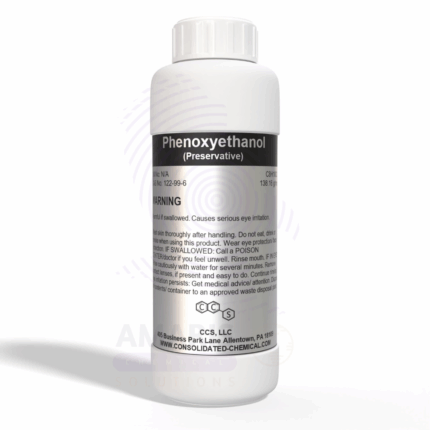
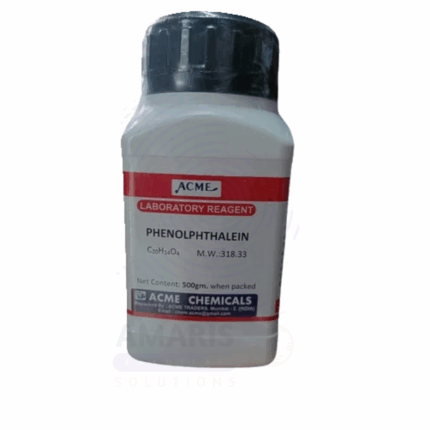
Sodium Propyl Paraben
Sodium Propyl Paraben is the sodium salt of propylparaben, a white to off-white crystalline powder or granule with the chemical formula C₁₀H₁₂NaO₃. It is a water-soluble antimicrobial preservative used extensively in personal care, pharmaceutical, and food products. Packaged in 25kg containers, it offers excellent stability and effectiveness over a wide pH range. Its antifungal and antibacterial properties make it a reliable choice for preventing microbial contamination and extending shelf life.
Sodium Propyl Paraben
Primary Uses
Personal Care & Cosmetics
- Preservative in Creams and Lotions: Inhibits microbial growth to maintain product safety.
- Shampoos & Conditioners: Prevents spoilage from bacteria and mold in aqueous formulations.
- Makeup Products: Used in foundations, mascaras, and lipsticks for shelf-life extension.
- Deodorants & Antiperspirants: Maintains microbial integrity in water- and oil-based systems.
- Wet Wipes & Facial Cleansers: Ensures hygiene by suppressing bacterial proliferation.
Pharmaceutical Industry
- Topical Medications: Preserves ointments, creams, and gels.
- Oral Suspensions & Syrups: Ensures microbiological stability in aqueous solutions.
- Injectable Solutions (Non-reactive Preservative): Occasionally used where sodium salts are preferred.
- Ophthalmic Preparations: Used in combination with other parabens for eye drops and gels.
Food Industry
- Preservative in Processed Foods: Used in baked goods, jams, jellies, and sauces (where permitted by regulation).
- Beverages: Controls yeast and mold in soft drinks and flavored waters.
- Snack Foods & Confectionery: Prevents fungal growth and spoilage in high-moisture environments.
Veterinary Products
- Preservative in Animal Health Formulations: Maintains shelf life of topical and oral animal treatments.
Secondary Uses
Industrial Applications
- Water-Based Adhesives: Preserves glue and bonding agents from microbial degradation.
- Paints & Coatings: Prevents mold formation in water-based interior paints.
- Textile Chemicals: Preserves dye pastes and softening agents.
Household Products
- Cleaning Solutions: Maintains product integrity in disinfectant wipes and sprays.
- Air Fresheners: Prevents degradation in gel- and water-based formulations.
Laboratory & Research
- Microbiological Media: Occasionally included in selective culture media as a fungistatic agent.
Pet Care Products
- Shampoos & Sprays for Pets: Used in grooming products to prevent microbial spoilage.
Basic Identification Attributes
- Chemical Name (IUPAC): Sodium 4-hydroxybenzoate propyl ester
- Common/Trade Name: Sodium Propyl Paraben
- CAS Number: 35285-69-9
- HS Code: 2918.29.00
- Synonyms: Propylparaben sodium salt, Sodium propyl-p-hydroxybenzoate
Physical & Chemical Properties
- Physical State: Crystalline powder or granules
- Color & Odor: White to off-white; faint odor
- Solubility: Freely soluble in water and alcohol
- Melting Point: Decomposes above 300°C
- pH (1% solution): 9.5–10.5
- Molecular Weight: 206.19 g/mol
Safety & Hazard Attributes
- GHS Classification: Not classified as hazardous under GHS
- Toxicity: LD₅₀ (oral, rat) > 5000 mg/kg
- Exposure Limits: No established occupational exposure limits
- Allergen Status: Generally recognized as non-sensitizing; rare allergic reactions reported
Storage & Handling Attributes
- Storage Conditions: Store in a cool, dry place; protect from light and moisture
- Container Type: 25kg fiber drums or HDPE-lined bags
- Shelf Life: 24 months in original sealed packaging
- Handling Precautions: Avoid dust inhalation; use with appropriate PPE
Regulatory & Compliance Attributes
- REACH Compliant
- FDA Approved (21 CFR 184.1670) – GRAS when used within limits
- USP/NF Compliant – Available in pharmaceutical grade
- Cosmetic Ingredient Review (CIR) – Assessed as safe when used as directed
- E Number: E217 (for food use; subject to regional restrictions)
Environmental & Health Impact
- Biodegradability: Readily biodegradable
- Ecotoxicity: Low; not expected to bioaccumulate
- Bioaccumulation: Not bioaccumulative
Aquatic Impact: Minimal at typical use concentrations
Safety Handling Precautions
- PPE Required: Gloves, safety glasses, dust mask
- Handling Guidelines: Use in well-ventilated areas; avoid creating dust
- Storage Measures: Keep containers tightly sealed; segregate from strong oxidizers
First Aid Measures
- Inhalation: Move to fresh air; seek medical attention if symptoms persist
- Skin Contact: Wash with soap and water
- Eye Contact: Rinse thoroughly with water for at least 15 minutes
- Ingestion: Rinse mouth; seek medical advice if large quantity consumed
Firefighting Measures
- Fire Hazards: Non-flammable; may decompose at high temperatures
- Extinguishing Media: Water spray, dry chemical, foam, or CO₂
- Hazardous Combustion Products: Carbon oxides, phenolic vapors


 Preservatives(food)
Preservatives(food) Flavor Enhancers
Flavor Enhancers Acidulants
Acidulants Sweeteners
Sweeteners Antioxidants
Antioxidants Colorants(food)
Colorants(food) Nutraceutical Ingredients (food)
Nutraceutical Ingredients (food) Nutrient Supplements
Nutrient Supplements Emulsifiers
Emulsifiers
 Collectors
Collectors Dust Suppressants
Dust Suppressants Explosives and Blasting Agents
Explosives and Blasting Agents Flocculants and Coagulants
Flocculants and Coagulants Frothers
Frothers Leaching Agents
Leaching Agents pH Modifiers
pH Modifiers Precious Metal Extraction Agents
Precious Metal Extraction Agents
 Antioxidants(plastic)
Antioxidants(plastic) Colorants (Pigments, Dyes)
Colorants (Pigments, Dyes) Fillers and Reinforcements
Fillers and Reinforcements Flame Retardants
Flame Retardants Monomers
Monomers Plasticizers
Plasticizers Polymerization Initiators
Polymerization Initiators Stabilizers (UV, Heat)
Stabilizers (UV, Heat)
 Antifoaming Agents
Antifoaming Agents Chelating Agents
Chelating Agents Coagulants and Flocculants
Coagulants and Flocculants Corrosion Inhibitors
Corrosion Inhibitors Disinfectants and Biocides
Disinfectants and Biocides Oxidizing Agents
Oxidizing Agents pH Adjusters
pH Adjusters Scale Inhibitors( water)
Scale Inhibitors( water)
 Antioxidants(cosmetic)
Antioxidants(cosmetic) Emollients
Emollients Fragrances and Essential Oils
Fragrances and Essential Oils Humectants
Humectants Preservatives
Preservatives Surfactants(cosmetic)
Surfactants(cosmetic) Thickeners
Thickeners UV Filters
UV Filters
 Fertilizers
Fertilizers Soil Conditioners
Soil Conditioners Plant Growth Regulators
Plant Growth Regulators Animal Feed Additives
Animal Feed Additives Biostimulants
Biostimulants Pesticides (Herbicides, Insecticides, Fungicides)
Pesticides (Herbicides, Insecticides, Fungicides)
 Active Pharmaceutical Ingredients (APIs)
Active Pharmaceutical Ingredients (APIs) Excipients
Excipients Solvents(pharmaceutical)
Solvents(pharmaceutical) Antibiotics
Antibiotics Antiseptics and Disinfectants
Antiseptics and Disinfectants Vaccine Adjuvants
Vaccine Adjuvants Nutraceutical Ingredients (pharmaceutical)
Nutraceutical Ingredients (pharmaceutical) Analgesics & Antipyretics
Analgesics & Antipyretics
 Analytical Reagents
Analytical Reagents Solvents(lab)
Solvents(lab) Chromatography Chemicals
Chromatography Chemicals Spectroscopy Reagents
Spectroscopy Reagents microbiology-and-cell-culture-reagents
microbiology-and-cell-culture-reagents Molecular Biology Reagents
Molecular Biology Reagents Biochemical Reagents
Biochemical Reagents Inorganic and Organic Standards
Inorganic and Organic Standards Laboratory Safety Chemicals
Laboratory Safety Chemicals Specialty Laboratory Chemicals(Special Laboratory Equipment)
Specialty Laboratory Chemicals(Special Laboratory Equipment)
 Demulsifiers
Demulsifiers Hydraulic Fracturing Fluids
Hydraulic Fracturing Fluids Scale Inhibitors(oil)
Scale Inhibitors(oil) Surfactants(oil)
Surfactants(oil) Drilling Fluids
Drilling Fluids
 Dyes and Pigments
Dyes and Pigments Bleaching Agents
Bleaching Agents Softening Agents
Softening Agents Finishing Agents
Finishing Agents Antistatic Agents
Antistatic Agents
 Admixtures
Admixtures Waterproofing Agents
Waterproofing Agents Sealants and Adhesives
Sealants and Adhesives Curing Compounds
Curing Compounds Concrete Repair Chemicals
Concrete Repair Chemicals Anti-Corrosion Coatings
Anti-Corrosion Coatings
 Surfactants(cleaning)
Surfactants(cleaning) Builders
Builders Enzymes
Enzymes Solvents (Cleaning)
Solvents (Cleaning) Fragrances
Fragrances
 Electronic Chemicals
Electronic Chemicals Catalysts
Catalysts Lubricants
Lubricants Photographic Chemicals
Photographic Chemicals Refrigerants
Refrigerants Automotive chemicals
Automotive chemicals Pyrotechnic Chemicals
Pyrotechnic Chemicals
 Biodegradable Surfactants
Biodegradable Surfactants Bio-based Solvents
Bio-based Solvents Renewable Polymers
Renewable Polymers Carbon Capture Chemicals
Carbon Capture Chemicals Wastewater Treatment Chemicals
Wastewater Treatment Chemicals
 Pigments
Pigments Solvents(paint)
Solvents(paint) Specialty Coatings
Specialty Coatings Binders/Resins
Binders/Resins Additives
Additives Driers
Driers Anti-Corrosion Agents
Anti-Corrosion Agents Functional Coatings
Functional Coatings Application-Specific Coatings
Application-Specific Coatings
 Fresh Herbs
Fresh Herbs Ground Spices
Ground Spices Whole Spices
Whole Spices Spice Blends
Spice Blends Dried Herbs
Dried Herbs
 Leavening Agents
Leavening Agents Dough Conditioners
Dough Conditioners Flour Treatments
Flour Treatments Fat Replacers
Fat Replacers Decoratives
Decoratives Preservatives(baking)
Preservatives(baking)
 Plasticizers & Softeners
Plasticizers & Softeners Reinforcing Agents
Reinforcing Agents Adhesion Promoters
Adhesion Promoters Vulcanizing Agents
Vulcanizing Agents Antidegradants
Antidegradants Blowing Agents
Blowing Agents Fillers & Extenders
Fillers & Extenders Accelerators & Retarders
Accelerators & Retarders


